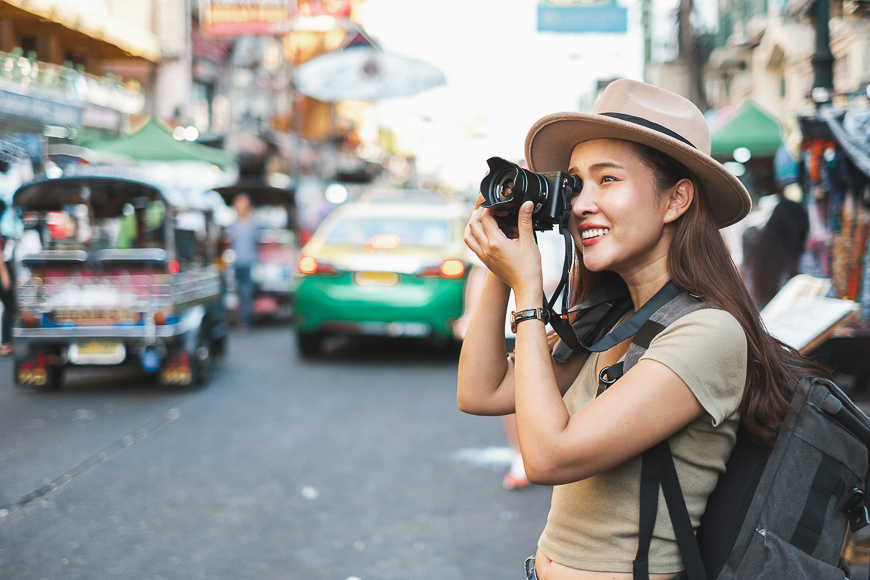
Check out our latest products
In our guide to the best mirrorless cameras for travel, we’ll unpack the essential specs, features, and performance, plus the all-important factor: how much of a joy they are to shoot with.
This guide is about the best interchangeable lens cameras for travel. Of course, many folk prefer to take a much smaller, almost pocketable compact camera when they travel.
Since travel cameras are best small, we’ve selected the best digital mirrorless offerings from leading brands to capture the magic of your next adventure.
HIGHLY RECOMMENDED

Stylish and portable body offering exceptional performance and a wide range of lens options.
I’ve travelled extensively with my camera gear and have learned a thing or two about what makes a perfect travel camera system.
The most significant advice I can offer is to select a lightweight camera that supports lightweight lenses. Read on to discover why!
Are Mirrorless Cameras Good for Travel Photography?
Over the last decade, I’ve travelled a bit with my camera gear—interstate and abroad. One thing that I’ve found to be true is that in many cases, less is more.
Large-body full-frame or medium-format digital cameras and big, heavy glass are fantastic for ensuring the best high-resolution travel shots possible.
However, carrying big, heavy camera gear for any extended period will weigh you down and eventually make you regret carrying so much gear. It will quickly erode your joy of photography and the travel experience.
Consider your everyday travel bag and the essentials you must pack for a trip: a phone, battery bank, passport, water bottle, snacks, medications, an all-weather jacket, and the ever-present tangle of charging cables, headphones, and keys.
Add your large camera kit, and suddenly, you’ve transformed from happy intrepid traveller to sad porter. Not to mention getting that much weight approved as carry-on luggage if you’re flying.
Digital mirrorless cameras are typically lighter and more compact than their larger DSLR counterparts. Plus, with advancements in lens technology, even full-frame mirrorless lenses are reducing in size and weight.
I’ve traveled to Japan four times in the past decade, each time with my Fujifilm X Series camera and lens kit.
I packed every lens I owned the first time, but I soon discovered that traveling with an APS-C X Series camera and two or three compact lenses is an ideal travel kit.
The 7 Mirrorless Cameras I Think Are Best for Travel
Traveling with a camera is all about portability and accessibility while capturing your experiences.
While APS-C and Micro Four Third cameras are typically smaller and lighter than full-frame bodies, many photographers choose to travel with bigger mirrorless bodies.
Of course, it all boils down to personal choice, what camera and lenses you already own, and the sort of outcomes you hope to gain.
One key feature of the best travel cameras is portability, and many of the cameras in this list were chosen accordingly.
Keep in mind, though, that not every camera fits well in every hand, and smaller cameras can be challenging for larger hands, especially. It’s best to go to a store and try out any camera before buying.
Fujifilm X-T5 (Best All-Around)


- Retro design aesthetics
- Flagship photography performance
- Excellent image and video quality
- Lightweight and portable
- Brilliant lens options
- Weather-sealed
- Premium price
- Autofocus is not on par with Sony
In 2015, I travelled to Tokyo, Japan, for the first time and shot over 7,000 images with my trusty Fujifilm X-T1.
The Fujifilm X-T1 was the OG flagship photography camera offering sharp image quality, excellent low-light performance, and Fujifilm’s impressive colour science.
Most importantly, the X-T1 was incredibly light, compact, and portable, offering comfortable ergonomics and an enjoyable shooting experience.
Since then, the X-T series has advanced significantly and proven innovative, powerful, and creative, while offering an exceptional travel camera experience.
The latest Fujifilm X-T5 is the brand’s flagship digital mirrorless body, supported by over 40 prime and zoom lenses ranging from entry-level to pro-grade glass.
Be sure to check out our full Fujifilm X-T5 review here!


Fujifilm’s X-T5 is an excellent combination of performance and portability. It boasts a 40MP APS-C X-Trans CMOS 5 HR BSI sensor, X Processor 5, and 7-Stop In-Body Image Stabilization (IBIS).
It’s a powerhouse based on those three specs alone – but it goes on!
The weather-sealed X-T5 also features a bright and punchy 3.69 m-Dot OLED Electronic Viewfinder (EVF), 3″ 1.84 m-Dot Tilting Touchscreen LCD, and the ability to shoot 20 fps with the electronic shutter and 15 fps with the mechanical shutter.
Regarding capturing holiday videos, the X-T5 records 4K 60p or a staggering 6.2K 30p 4:2:2 10-bit video.
Plus, if you don’t like editing RAW image files or want to share your holiday snaps on the go, nothing beats Fujifilm’s JPEG color, thanks to the comprehensive range of Film Simulations replicating classic film stock.
Fujifilm’s flagship photography camera weighs 19.6oz (557g ) with a battery and memory cards (dual UH-S II Slots) and measures a neat 5.1 x 3.6 x 2.5″ (129.5 x 91 x 63.8mm).
It’s a compact and lightweight powerhouse ideal for any travel adventure.
Sony Alpha A7C II (Best Compact Full-Frame)
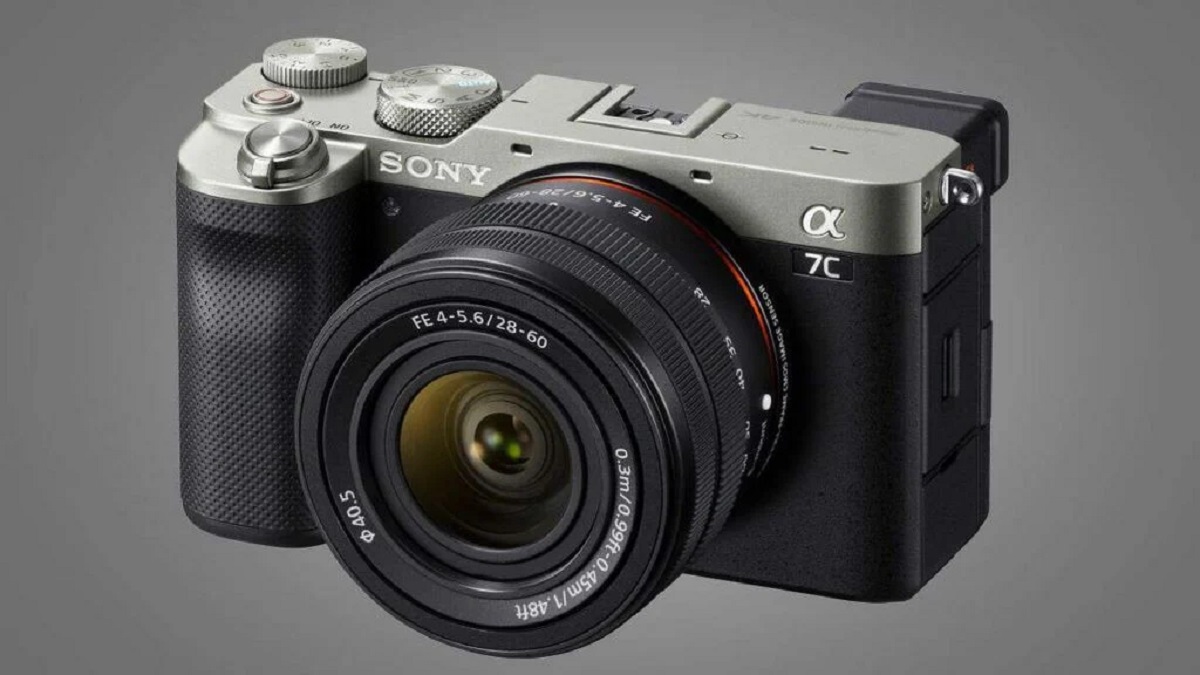

- Impressive full-frame offering
- Lightweight and compact
- High-resolution images
- Fast autofocus performance
- Image stabilization
- Video and vlog-friendly
- Lackluster LCD screen
- Not for big hands
Another worthy player in the portable mirrorless camera market is the Sony Alpha A7C II – a full-frame yet compact digital mirrorless body with access to stunning first and third-party lenses.
The Sony A7C II is the second generation entry in the highly acclaimed A7C series – it was so good the first time, and they made it even better!
Sony’s A7C II is one of the tiniest full-frame cameras on the market. It weighs just 1.1lb (514g) – lighter than the APS-C X-T5 – and measures 4.9 x 2.8 x 2.5″ (124 x 71.1 x 63.4mm).
The A7C II packs a 33MP Full-Frame Exmor R BSI image sensor, is powered by the BIONZ XR Image Processor, and supports 7 Stops of In-Body Image Stabilization (IBIS).


Putting aside the standout specs, the Sony also features a 2.36 m-Dot OLED Electronic Viewfinder (EVF), a lackluster 3″ 1.03 m-Dot Vari-Angle LCD Touchscreen, and delivers a reasonable 10fps burst.
For video and recording travel vlogs, the Sony A7C II captures 10-bit full-frame 4K 30p video, while the onboard AI Processing Unit effortlessly recognizes and tracks specific subjects to keep them in frame at all times.
Plus, the flip-out and rotating touch screen allows instant access to key video shooting info and controls at a touch.
From an ergonomic point of view, the A7C II is a compact camera and may not suit photographers with larger hands.
Having said that, Sony offers extensive customization of command dials and function buttons, allowing you to set up the camera to suit your needs.
The Sony A7C II is an ideal travel camera thanks to its portability, performance, and impressive lens mount, which supports countless first—and third-party zoom and prime lens options. It’s among the best Sony cameras for photographers and videographers!
Panasonic Lumix S5 II (Best Hybrid)
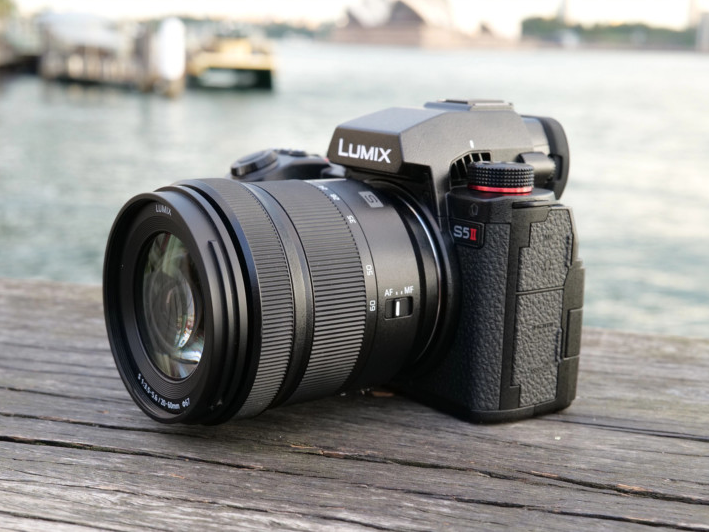

- Pro-grade video capabilities
- Full-frame image quality
- Great ergonomics
- Best IBIS in class
- Bigger and bulkier travel camera
- Slower focusing performance
One of the unsung heroes of the digital mirrorless camera trend is the Panasonic LUMIX S5 II – we reckon it’s the best hybrid stills and video content creation camera around.
The LUMIX S5 II (another camera that’s received a considerable upgrade from the Mark I) is a full-frame hybrid shooter’s dream machine thanks to impressive specs, performance, and handling.
Be sure to read our full review here!
Panasonic’s S5 II perfectly straddles the boundary between pro-grade video output and high-quality photography. LUMIX is often considered a key player in the videography camera market.
The S5 II boasts a 24.2MP Full-Frame CMOS image sensor designed for hybrid performance. It also features 5-axis Sensor-Shift Image Stabilization (IBIS) for optimal low-light and slow-speed performance.
If advanced video recording is important to you, the LUMIX can record unlimited C4K/4K 60p 4:2:2 10-bit video and a mighty 6K 30p 4:2:0 10-bit recording.
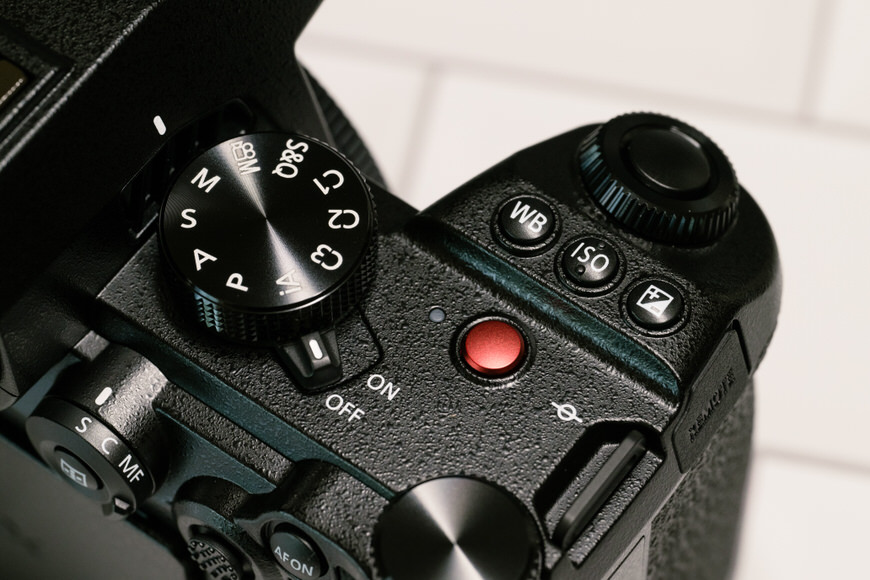

Focus performance is assured thanks to the Phase Hybrid 779-Point Phase-Detection AF System- the first camera to feature this new autofocus system.
The Panasonic LUMIX S5 II is more than a videography powerhouse. It features an impressive. 3.68 m-Dot 0.78x-Magnification OLED LVF (EVF) and a reasonable 3.0″ 1.84 m-Dot Tilt/Free-Angle Touch-LCD.
Plus, the LUMIX supports dual UHS-II fast SD card readouts and recording speeds.
While the S5 II packs a lot of performance, it comes at the cost of size and weight. Where the Sony A7C II is sleek, compact, and lightweight, the LUMIX is a larger, bulkier, and heavier mirrorless camera.
Before investing in the system, travellers must consider the camera’s 1.64 lb (744g) weight and 5.29 x 4.03 x 3.55″ (13.44 x 10.24 x 9.02cm) dimensions. Add to that the weight of premium L-mount lenses, and your travel kit may bulge a little.
However, while the X-t5 and the Sony A7C II have excellent video capabilities, the S5 II outshines them both.
OM System OM-D E-M10 Mark IV (Best Under $700)


- Affordable camera and lens offering
- Compact camera and lenses
- Lightweight at 13.5 oz (383g)
- Excellent video and image performance
- Low-resolution LCD
- Odd flip-down selfie screen
It’s important to understand that not all travel cameras must be high-end full-frame beasts. Sometimes, when travelling on a budget or wanting to keep your kit as light as possible, you need a quiet achiever.
Mirrorless cameras come in all shapes and sizes while delivering epic travel shots and video shorts. Perhaps it’s time to consider a micro-four-thirds camera such as the OM System (formerly Olympus) OM-D E-M10 Mark IV.
If you’re looking for an excellent new camera for travel under $700, the Olympus OM-D E-M10 Mark IV is hard to beat.
It’s quite light and easy to carry around. It has image stabilization and is good for both stills and video. You can currently get it with a 14-42mm kit lens for just under $700.


Just quickly, the M.Zuiko 14-42mm f/3.5-5.6 II R lens produces a travel-friendly 28-84mm full-frame equivalent focal range. The sharp and fast lens is lightweight at 3.99 oz / 113 g and incredibly tiny at 2.2 x 1.9″ (55.9 x 48.3mm).
The E-M10 Mark IV packs a 20.3MP Live MOS Micro Four Thirds image sensor, TruePic VIII Image Processor, and 5-Axis Sensor-Shift Image Stabilization (IBIS) for night and slow-speed shooting.
The retro-inspired aesthetics may not be for everyone, but for anyone who loves the look of the Fujifilm X-T5 but wants a lighter body, this may be for you.
OM System’s E-M10 Mark IV also features a bright 2.36 m-Dot 0.67x-Magnification OLED EVF and a less-than-ideal 3.0″ 1.04 m-Dot 180° Tilt Touchscreen.
OM System (formerly Olympus) has been in the camera, lens, and optics game for over a century. It continues to design and deliver impressive MFT cameras, lenses, and systems to suit every genre and skill level.
Canon EOS R50 (Best for Beginners)


- Beginner-friendly and affordable
- Excellent lens choices
- Compact and lightweight
- Great image quality
- Feels a little hollow and plastic
- Limited video options
Canon is a renowned household name in the world of photography, cameras, lenses, printers, and industrial optics. It’s one of the longest-running brands and has been in the game for nearly 90 years.
Famous for film, SLR, and DSLR camera and lens systems, the brand is now considered a leader in the pro-grade mirrorless camera space.
Of course, not every Canon mirrorless camera is a full-frame beast like the recent R5 Mark II. Canon also offers a wide range of APS-C digital mirrorless cameras that are smaller, weigh less, and are ideal for travel.
The Canon EOS R50 is an APS-C format mirrorless camera with a 24.2MP APS-C CMOS image sensor and a fast DIGIC X Image Processor.
Despite being a beginner-friendly camera, the R50 features impressive features, including a 3.0″ 1.62m-Dot Vari-Angle Touchscreen, a 2.36m-Dot Electronic Viewfinder (EVF), and an amazing 15 fps Electronic Shutter burst mode.
The R50 is also one of the lightest cameras on this list, weighing just 13.2 oz (375g) and measuring a compact 4.6 x 3.4 x 2.7″ (116.3 x 85.5 x 68.8 mm).


Beginner content creators travelling the world to document experiences will love the video capabilities of this surprising mirrorless camera.
We highly recommend the R50 as one of the best Canon cameras for beginners!
The EOS R50 records UHD 4K 30p video while supporting Vertical Movie Mode for reels and posts, and Close-Up Demos Mode for showcasing your travel haul.
Canon is known for developing pro-grade, class-leading cameras and incredible lenses for full-frame and APS-C bodies.
Check out our guide to the best lenses for the Canon R50.
While Canon doesn’t allow third-party brands to develop lenses for full-frame EOS R mount cameras, the APS-C R mount is open to all, and many leading brands offer incredible lens choices.
Sony a7R V (Best for Professionals)


Image credit: Sony
- Insanely fast autofocus performance
- Crazy image resolution
- Impressive video
- Sees in the dark
- Expensive travel option
- Massive file sizes
If you’re a professional photographer, videographer, or leading content creator, you demand exceptional image quality, advanced autofocus, and good battery life – even when on holiday!
Back in the Sony stable, the A7R V is one of the most acclaimed and beloved offerings in full-frame digital mirrorless cameras and makes one hell of a travel kit.
It’s a powerhouse ideal for capturing top-tier stills and video content to record and celebrate every travel experience to the fullest.
Let’s look at the beastly specs! The Sony A7R V packs a wholloping 61MP Full-Frame Exmor R BSI CMOS image sensor powered by dual BIONZ XR processor and AI Processing Unit. Just let that sink in for a moment!
The class-leading Sony boasts a 9.44-m-dot EVF with a 120 fps Refresh Rate – one of the highest-resolution EVFs on the market.
The rear screen is a super bright, high-resolution 3.2″ 4-Axis Multi-Angle Touchscreen LCD pumping out 2.1 m-dot of image resolution.
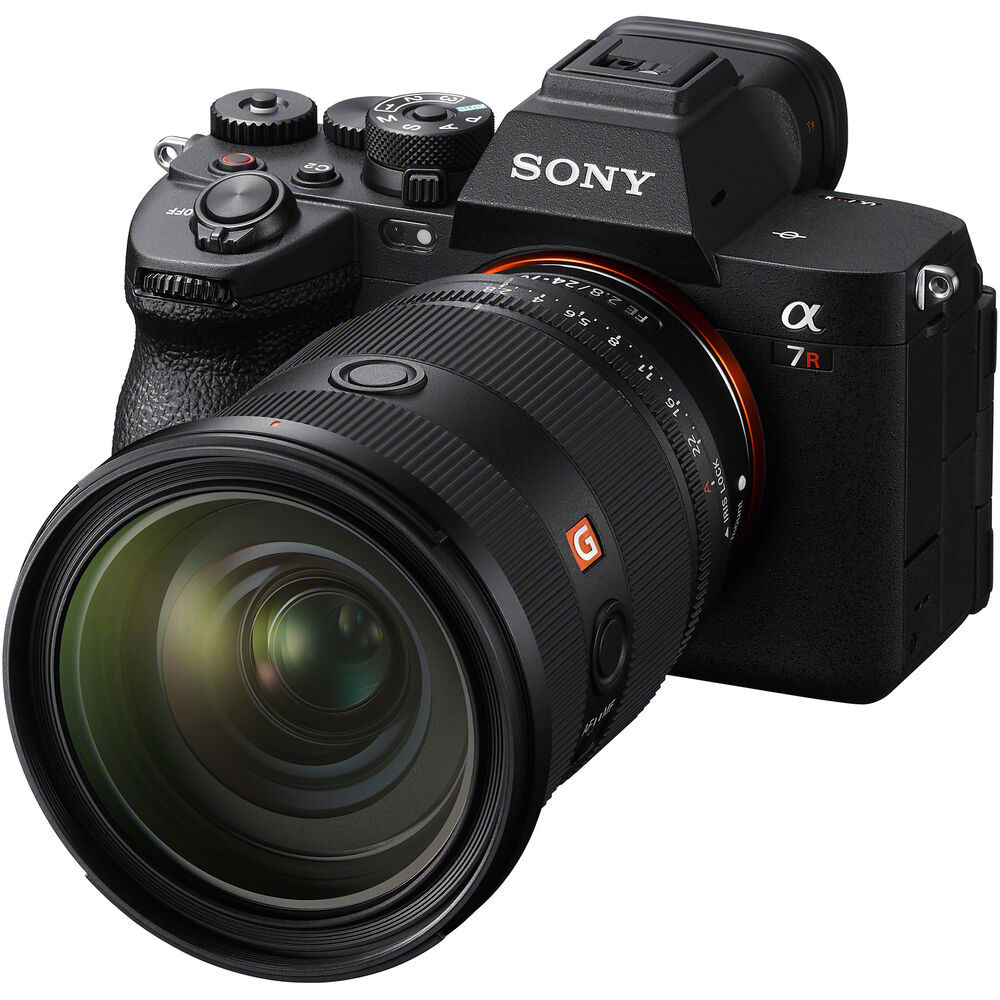

The good times don’t stop there! The pro-level Sony A7R V features 8-stop 5-axis Image Stabilization (IBIS), an AI-based real-time Tracking AF System (it’s one of the fastest in the business), dual CFexpress Type A/SD card slots, and 10 fps Shooting with AF/AE Tracking.
While the A7R V is a cracker of a photography camera, its video capabilities make it even more impressive. Sony’s mirrorless camera records 8K 24p, 4K 60p, FHD 120p 10-bit video, and 4K 16-bit Raw Output; S-Log3/S-Cinetone.
At 1.6lb (723 grams) with battery and memory card, it’s one of the lightest high-resolution cameras available.
Of course, being able to record your travels in 8K and capture stunningly crisp images via the 63MP full-frame sensor comes at a considerable cost that only pros need apply.
Regardless, the mirrorless camera scored top marks in our full review!
Having said that, if you’re a professional visual creative capturing your personal or work travels, the Sony Alpha A7R V will never let you down, no matter the conditions, genre, or situation.
Sony ZV-E1 (Best for Vlogging)


- Compact and portable for vlogging
- Fast autofocus performance
- Outstanding video options
- Impressive Sony lens range
- Lacks a mechanical shutter
- Can overheat with high-spec video
Sticking with the Sony-love, let’s take a look at one of the most impressive content creation cameras available today!
The Sony ZV-E1 digital mirrorless camera is a content creator’s dream machine thanks to its compact form, savvy features, and hybrid content-friendly performance ideal for social media, vlogging, and travel experiences.
Sony’s ZV-E1 is an impressively compact full-frame mirrorless travel camera that measures 4.8 x 2.8 x 2.1″ (121 x 71.9 x 54.3mm) and weighs just 1.1 lb (483g).
Available in black or white, the Sony ZV-E1 is also available as a kit with the video and vlog-friendly Sony FE PZ 16-35mm f/4 G power-zoom lens.
The 16-35mm f/4 lens is ideal for vlogs as the wide angle ensures that your ‘talking head’ is always in frame. Plus, the lens features a power-zoom function allowing you to alter the focal distance with the press of a button.


Explicitly designed for hybrid content capture, the ZV-E1 packs a 12MP Full-Frame Exmor R CMOS image sensor delivering 15+ stops of dynamic range and an extended ISO range of 80-409,600!
While it’s one of the smallest full-frame interchangeable lens cameras, its video performance, output, and features are impressively vast.
The Sony ZV-E1 captures stunningly detailed UHD 4K 120p / FHD 240p, 10-bit 4:2:2 internal recording, while its heat dissipation design allows for 4K 60p recording up to an hour uninterrupted.
While that sounds great on paper, many users report overheating issues with the camera, especially when recording in the highest quality at the highest bit rate.
Putting that aside, the ZV-E1 also offers multi-face recognition tracking, time-lapse creation, product showcase settings, and enough ports to meet any videographer’s needs.
While it’s not a perfect system, it’s an impressive travel-friendly performer given its size, weight, and content creation features.
What Makes a Great Mirrorless Travel Camera?


A great mirrorless travel camera is the one you always have on you. At the end of the day, it doesn’t matter if you’re capturing your experiences on the smartphone in your pocket or on a $20,000 pro-grade kit.
You’re living the dream as long as you’re present, experiencing the moment, seeing new sites, meeting fascinating people, and seeing the world.
Capturing those moments and experiences should always be secondary to seeing them with your own eyes and marveling at the world around you.
Of course, having a camera on hand means you can capture those moments and build memories that last forever.
Choosing a great mirrorless travel camera is all about personal choice and how you intend to use the images and videos once you’re back home from your trip. Let’s take a look at the key considerations.
Image Quality


If you hope to capture stunning images while travelling, you need a mirrorless camera with a reasonable MP count on the image sensor – MFT, APS-C, or full-frame.
I recommend anything above 26MP for sharp and detailed images. If you want higher resolutions to print large, you’ll need a higher megapixel count and/or a full-frame camera.
The better the image sensor, the better the camera performs – greater resolution, expanded ISO range, increased dynamic range, and shadow/highlight control.
Video Quality


If you want to capture video-centric content of your travels, you’ll need a camera with significant video performance.
Aim for a mirrorless camera with a minimum 4K 30p/60p video resolution and the ability to crop the frame and resolution for use in a variety of media applications.
Video performance relies less on high-density megapixel counts and more on the quality of detail each pixel captures. However, a higher resolution image sensor provides more cropping and format options.
Another key aspect of a great travel camera is the available ports to connect headphones for monitoring audio, a microphone for improved outdoor audio capture, and a USB-C or HDMI (Mini or Full) port for recording to an external monitor.
Ergonomics


As mentioned, traveling with a camera kit quickly teaches you how heavy your gear is, especially after a long day on foot or hiking to remote locations.
Ergonomic considerations are essential for travel cameras – they can make or break your experience.
Look for a travel camera that’s lightweight and relatively compact without compromising the device’s build quality, weather sealing, or robustness.
Cameras with built-in grips offer greater comfort than those without and are ideal for photographers with bigger hands.
Another key aspect of ergonomics is the usability of the EVF and rear LCD. An EVF should be bright, offer excellent resolution and refresh rate, and feature a diopter for those with glasses or poor eyesight.
Budget
The budget is the most important aspect of selecting the best mirrorless camera for travel. It supersedes all other considerations.
Before you head into a camera store, know what budget you are working with and do some online research to narrow down your choices.
At the end of the day, if you can’t afford it, chances are there’s a cheaper alternative without too many sacrifices.
Travelling locally, interstate, or overseas can be costly. Adding $4K or $5K to your credit card debt just to get the best camera is fine now, but it will hurt when you return home to the overdue notice.
Another aspect of the budget is considering the available lenses and their costs. It’s all very well to buy a good mirrorless camera for under $2K, but if you have to spend another $3K on lenses, you’ll be right back where you started.
Many third-party developers make affordable lenses for various lens mounts and camera systems. You don’t always have to buy the Canon lens to suit your Canon camera. Chances are, there’s a cheaper option that’s just as good.
Is a Full-Frame Sensor Better Than an APS-C or Micro Four-Thirds Sensor for Travel?


Full-frame, APS-C, and Micro Four-Thirds are the most common and known camera image sensor sizes. All the cameras recommended above feature one of these sensor types.
The sensor type also determines the physical size of the image sensor. For more info on all the sensor types, check out our guide here.
However, knowing that each sensor type can accommodate varying pixel densities is also essential.
For example, Fujifilm’s X Series cameras feature an APS-C image sensor measuring 23.6 x 15.6mm. However, the flagship X-T5’s image sensor features 40MP of image resolution or 7728 x 5152 pixels.
The exact size of the APS-C image sensor in a Fujifilm X-M5 only results in 26.1MP or 6240 x 4160.
Full-frame image sensors are much larger than APS-C, measuring 36 x 24mm. They typically feature higher resolutions or larger MP counts.
The Canon R5 Mark II boasts a full-frame image sensor with 45MP or 8192 x 5464 pixel density. This camera’s full-frame image sensor can capture higher image resolution, resulting in sharper, more detailed shots.
It’s also worth noting that some brands only make micro-four-thirds systems, while others offer APS-C, medium format, and full-frame systems.
Which is best for travel depends on personal preference. If you want rich, detailed, high-resolution images that you can print large, a full-frame camera is your best bet. However, full-frame cameras are usually more expensive than APS-C and MFT options.
APS-C cameras with a 40MP image sensor also capture stunning detail and resolution and are typically cheaper than full-frame bodies.
Does Brand Matter?


I’m a big believer in selecting the best camera (and not the brand) for you. Despite being a Fujifilm fan-boy, I know Fujifilm X or GFX cameras and lenses aren’t for everyone.
Fujifilm works for me as I have some physical limitations and can’t carry or hold a camera and lens combo that’s too heavy. I must travel with a lightweight and compact kit to ensure I grab the holiday shots I want while also loving the process.
When it comes to selecting the best travel camera for you, focus on the features, ergonomics, and performance rather than the badge that was slapped on top of it.
Before you even set foot in a camera store or shop online, do a little research to determine the best features, performance, and outcomes you desire.
But also consider your budget, skill level, and what you hope to achieve with a mirrorless camera while exploring the world.
As for brand, yes, some brands are better than others. But that doesn’t mean that the best brands offer the best camera for you.
FAQs About the Best Mirrorless Cameras for Travel
Are mirrorless cameras better than DSLRs for travel?
Mirrorless cameras are typically lighter and more compact than older DSLR camera options. DSLR lenses often feature older technology, resulting in larger and heavier lenses compared to their mirrorless counterparts.
Is a Micro Four-Thirds sensor good enough for a travel camera?
Yes. A micro four-thirds camera is ideal for travel as it’s typically much smaller and lighter than a full-frame option while still offering excellent image and video quality.
Which is better for travel: a compact camera or an interchangeable lens camera?
While compact cameras are incredibly travel-friendly, they feature smaller image sensors with lower resolutions, poorer image quality, and substandard video output. Interchangeable lens cameras (like those listed above) offer greater features, performance, and outcomes. Plus, you have more flexibility with the lenses you wish to travel with.

![[2025 Upgraded] Retractable Car Charger, SUPERONE 69W Car Phone Charger with Cables Fast Charging, Gifts for Men Women Car Accessories for iPhone 16 15 14 13 12, Samsung, Black](https://i1.wp.com/m.media-amazon.com/images/I/61SaegZpsSL._AC_SL1500_.jpg?w=300&resize=300,300&ssl=1)



![[True Military-Grade] Car Phone Holder【2024 Stronger Suction & Clip】 Universal Cell Phone Holder for Car Mount for Dashboard Windshield Air Vent Long Arm Cell Phone Car Mount Thick Case,Black](https://i2.wp.com/m.media-amazon.com/images/I/715PBCuJezL._AC_SL1500_.jpg?w=300&resize=300,300&ssl=1)
![[エレコム] スマホショルダー ショルダーストラップ 肩掛け ストラップホールシート付属 丸紐 8mm P-STSDH2R08](https://i3.wp.com/m.media-amazon.com/images/I/51BMFf06pxL._AC_SL1500_.jpg?w=300&resize=300,300&ssl=1)







